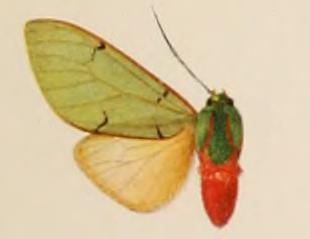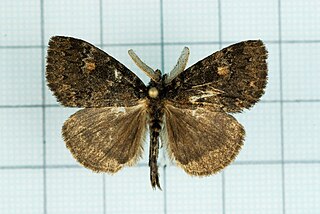Sir George Francis Hampson, 10th Baronet was an English entomologist.

Urodidae, whose species are commonly known as false burnet moths, is a family of moths in the lepidopteran order. It is the type genus in the superfamily, Urodoidea, with three genera, one of which, Wockia, occurs in Europe.
Metachanda is the sole genus in tribe Metachandini of moth subfamily Oecophorinae. Metachandini was originally described as family Metachandidae by Edward Meyrick in 1911, and at the time also contained the genus Chanystis, which is currently unplaced to tribe within Oecophorinae. It has also previously been described as tribe Metachandini of subfamily Gelechiinae.

Agathiphaga is a genus of moths, known as kauri moths. and is the only living genus in the family Agathiphagidae. This caddisfly-like lineage of primitive moths was first reported by Lionel Jack Dumbleton in 1952, as a new genus of Micropterigidae.

Antichloris is a genus of tiger moths in the family Erebidae. The genus was erected by Jacob Hübner in 1818.

Chlorhoda is a genus of moths in the subfamily Arctiinae erected by George Hampson in 1901.

The Thyatirinae, or false owlet moths, are a subfamily of the moth family Drepanidae with about 200 species described. Until recently, most classifications treated this group as a separate family called Thyatiridae.
Procrimima is a genus of moths in the subfamily Arctiinae.

Daseochaeta is a genus of moths of the family Noctuidae. The genus was described by Warren in 1907.

Ilema is a genus of tussock moths in the family Erebidae. The genus was described by Walker in 1855 and renamed by Moore in 1860, because Walker's chosen name was preoccupied.
Celonoptera is a monotypic moth genus in the family Geometridae. Its only species, Celonoptera mirificaria, is found in south-eastern Europe. Both the genus and species were first described by Julius Lederer in 1862.

Lerema is a genus of skipper butterflies in the family Hesperiidae.

Niconiades is a genus of skipper butterflies in the family Hesperiidae.
Victor Gurney Logan Van Someren was a zoologist and entomologist. Van Someren was born in Australia. He attended George Watson's College and studied zoology at University of Edinburgh. He was also a dentist. Van Someren moved to Kenya in 1912 and lived in Nairobi. He was in the East Africa and Uganda Natural History Society and became Honorary Secretary. In 1930 he became Curator of the Coryndon Museum. Van Someren named a number of bird and butterfly species.
Hypomolis viridis is a moth of the family Erebidae. It was described by Herbert Druce in 1903. It is found in Peru.

Leucopleura viridis is a moth of the subfamily Arctiinae. It was described by Max Gaede in 1926. It is found in Amazonas, Brazil.
Procrimima procris is a moth in the subfamily Arctiinae. It was described by Felder in 1875. It is found in Colombia and Peru.
Trichura viridis is a moth in the subfamily Arctiinae. It was described by Max Gaede in 1926. It is found in Colombia.








